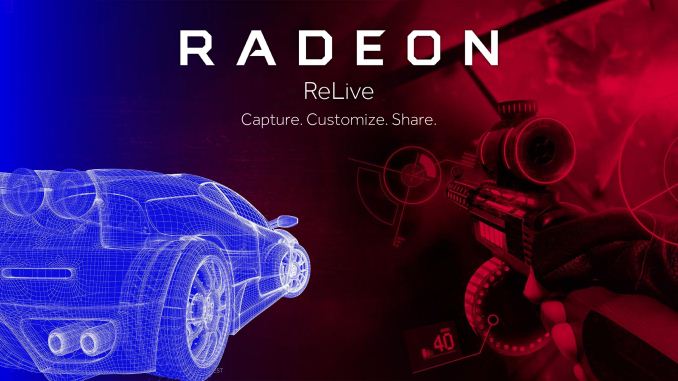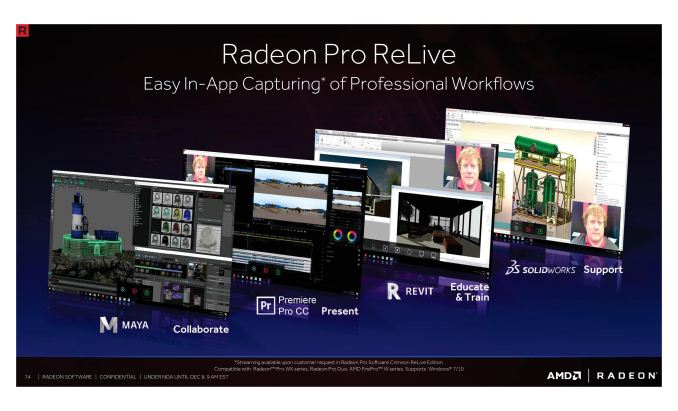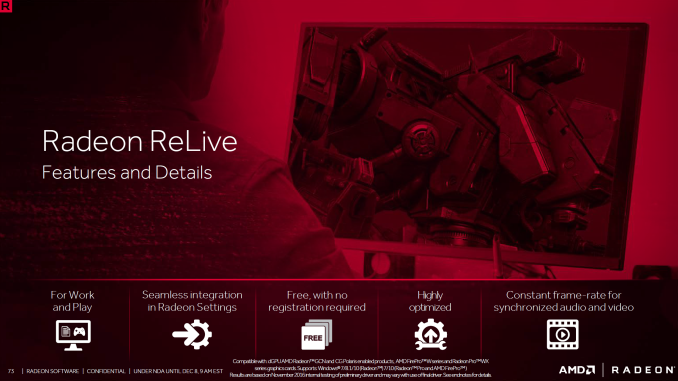AMD Delivers Crimson ReLive Drivers: Yearly Feature Update for Radeon Gamers and Professionals
by Ian Cutress on December 8, 2016 9:00 AM ESTReLive
The biggest part of the ReLive launch, despite the major amount of updates, fixes and new features, is actually the ‘ReLive’ itself, or ‘re-live’. Basically on our hands is an on-screen recording tool that implements integration to streaming services and offers options for professionals to demonstrate or promote with overlay and webcam features all while giving a minimal impact to performance.
So clearly there are plenty of gaming capture software suites already available on the market such as XSplit, individual webcam software, and even a Game DVR capture tool built directly into the latest editions of Windows 10. One of the key advantages AMD claims it has over all the others is that being a GPU manufacturer means they can interact with the hardware in ways the others cannot, leading to a much lower overhead and better experience than the rest. Also, it comes free with the driver software and doesn’t require a license.
Aside from the obvious game streaming aspect most users are familiar with, AMD is promoting ReLive as a professional tool as well, bundled with the requested versions of the Pro software set. The blurb from AMD states that using a tool such as ReLive can help with training and remote presenting, not to mention that AMD is also certifying the tool with commercial software packages as required.
ReLive will support direct streaming into many online video services such as YouTube and Twitch, as well as a gamut of popular Asian streaming websites (panda.tv, Douyu, Huya, Longzhu). Control for ReLive’s features will be via an in-app toolbar, offering instant replay of up to 20 minutes of onscreen footage and custom hotkey support for things like overlay images and webcam positioning.
Support for ReLive will be on all GCN enabled discrete graphics cards for Windows 7/8/10, and for Pro WX and FirePro W-series cards on Windows 7/10.














48 Comments
View All Comments
PseudoKnight - Thursday, December 8, 2016 - link
"took a few seconds..." cracked me uplol, now i'm imagining you starting up your download manager just in case your sister makes a phone call and you have to resume the download later.
A5 - Thursday, December 8, 2016 - link
It's possible the board designs spec a different HDMI/DP chip that supports it or something.Probably just a testing or marketing thing though.
Colin1497 - Thursday, December 8, 2016 - link
Yeah, I have a box with a 285 in it (my son's). Doesn't have an appropriate monitor today, but the monitor is the next thing to get replaced, so it was personal interest driving the Q. :)Manch - Thursday, December 8, 2016 - link
Was wondering the same thing. Why the rebadge only. Ill start the download :D as soon as I get home. Then I'm requesting the feature for my 290X'snathanddrews - Thursday, December 8, 2016 - link
The only differences over Hawaii that I know of are that Grenada has refined power delivery, power management, and faster 6 GHz VRAM. Pretty sure that Grenada and Hawaii share the same encode/decode blocks and display outputs, but it's possible that Grenada shipped with higher speed DisplayPort ports and it was never published due to the lack of concrete validation methodology at the time, but I doubt it. Pretty sure AMD/NVIDIA just buy DP/HDMI port hardware/controllers in bulk and order whatever is available at the time.Technically, HDR10 metadata can be streamed using older display connections (just like Dolby Vision), but without monitor/TV support, I'm curious to what AMD has planned. My guess is HDR10 will be limited to 8-bit Rec.709 on Grenada, whereas Polaris will get support for HDR10 10-bit Rec.2020, based upon port capabilities alone.
Why TongaXT is included in the mix and not Hawaii, I don't know.
testbug00 - Sunday, December 11, 2016 - link
Tonga is GCN gen3, Hawaii is GCN gen2.Gen1=Cape Verde, Pitcairn, Tahiti.
Gen2= Bonaire, Hawaii
Gen3= tonga, Fiji
Gen4= P11, P11
There is orland and I think one more 28nm GPU, but I do not know if they are gen 1, 2 or 3z
R3MF - Thursday, December 8, 2016 - link
"On the HDR front, AMD has been promoting that high end R9-300 series"What is it about a 390 series card that is absent in the 290 series card, to make the former compliant with HDR when the latter is not?
Is this purely HDR10 support, or does it include Dolby Vision as EA have said Mass Effect Andromeda will use on the PC? If not, do AMD think this matters?
ET - Thursday, December 8, 2016 - link
Hardware compatibility looks incomplete. It makes no sense for example that user feedback isn't available on APU's, or that VP9 4K60 works on discrete and Stoney Ridge but not on Bristol Ridge.R3MF - Thursday, December 8, 2016 - link
Re: Linux supportDoes "SLED/SLES 12" support indicate there will be a driver compatible with Opensuse Leap 42.2?
PseudoKnight - Thursday, December 8, 2016 - link
I really appreciate AMD adding features and improvements to even their five year old cards (own a 3 year old card). I've also liked this new direction they've been taking with their software since Crimson. It never felt quite finished (with some things being tacked on) but this looks like it might finally rounds things out. I'm particularly looking forward to testing out ReLive DVR. I suspect I'll stick with OBS Studio, but here's hoping it surprises me.